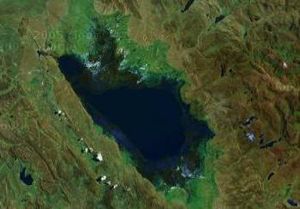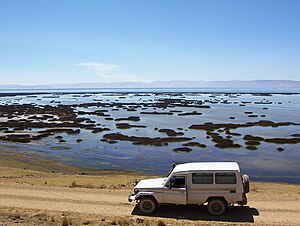Junín lake
|
Lake Junin Lake Junin, Chinchaycocha |
||
|---|---|---|

|
||
| Geographical location |
|
|
| Drain | (Río Upamayo →) Río Mantaro | |
| Places on the shore | Junín , Carhuamayo | |
| Data | ||
| Coordinates | 11 ° 1 ′ S , 76 ° 7 ′ W | |
|
|
||
| Altitude above sea level | 4082.7 m | |
| surface | 175 km² | |
| length | 28 km | |
| width | 13 km | |
| volume | 556 million m³ | |
| Maximum depth | 12 m | |
| Catchment area | 1800 km² | |
|
particularities |
flow regulated; |
|

|
||
| Lake Junín | ||
The Junín Lake ( Spanish Lago Junín ) or Chinchaycocha ( Quechua Chinchayqucha , "northern lake" or " Ocelot Lake ") is the second largest lake in South American Peru after Lake Titicaca .
location
The Junín Lake is 4082 m above sea level in the Meseta of Bombón in the Junín and Pasco regions .
size
The water level of the lake fluctuates between wet and dry years by up to 1.5–2 m. The size of the lake depends on the height of the water level, which is regulated today by the Upamayo dam at the natural outflow of the lake, the Río Upamayo . The lake has a maximum total volume of 556 million m³ of water - 441 million m³ of this can be used.
Junín Lake Nature Park
On August 7th 1974 the nature reserve of Junín was established, which includes the lake (area approx. 175 km²) and its immediate surroundings and has an area of 530 km².
The lake and the neighboring areas have an extraordinary variety of animals and plants with plant formations that are unique in the world. Mammals like the wild guinea pig ( Cavia tschudii ), frogs like the Batrachophrynus macrostomus , Andean pies like Orestias elegans and Orestias empyraeus , birds like the Puna diver and plants like the reed Totora are found here. The subspecies Rollandia rolland morresoni of Rolland-diver breeds exclusively at this lake.
Since 1933, the flora and fauna of the nature park have been damaged by residues from the mines in the region, as well as by sewage from the cities of Junín and Carhuamayo , which have since accelerated the natural eutrophication process of the wetland.
Web links
- Junín National Reserve at parkswatch.org
Individual evidence
- ^ Complejo Hidroenergético del Mantaro (Cuenca Hidrográfica del Rio Mantaro). Electroperú SA, accessed May 8, 2020 (Spanish).
- ↑ Hadoram Shirihai: A Complete Guide to Antarctic Wildlife - The Birds and Marine Mammals of the Antarctic Continent and Southern Ocean . Alula Press, Degerby 2002, ISBN 951-98947-0-5 , p. 237
